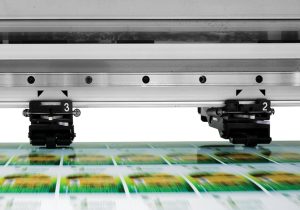Printing Ink Solutions Promote Sustainability

Sustainability in materials and processing is a durable trend in card manufacturing today. Most attention is given to energy efficiency and alternative materials. There is no doubt that these elements are paramount, but much can be and is being done on other initiatives as well.
Materials of construction in all layers of the card body have been adapted to high recycled content and alternative, plant-based plastics. But we can also see innovation at the interfaces to each of these card body layers. Solvent free and water-based inks and adhesives contribute to these overall sustainability initiatives.
Solvent free and water-based inks, with LED instead of UV curing systems, can provide a high degree of energy efficiency and can be applied both for offset and screen printing. These ink curing systems use less than half the energy of a traditional UV curing system and have 10 to 15 times longer life than traditional UV curing systems. Since many recycled and/or more environmentally friendly card substrate materials cannot be processed at the high temperatures of virgin PVC, these features can help enable these new processing requirements while adding to the reduction in the carbon footprint of overall manufacturing. Similarly, ink solutions being developed for digital printing promote not only energy efficiency but also contribute to lower scrap rates and printing flexibility needed for customization.
Outside the manufacturing of the card bodies themselves, attention is also focused on supporting processes at all points of manufacturing. Using renewable sources of energy for power generated in all equipment used needs to be considered. Low power alternatives, such as LED lighting throughout the plant, can contribute to reduction in carbon footprint. This is also part of the attraction discussed above in using LED ink curing systems as an alternative to UV curing systems. And the carbon footprint incurred in both receiving supplies purchased as well as delivering finished cards to customers needs to be considered as part of the plant’s sustainability goals.
Card personalization equipment today, using both drop-on-demand (DoD) and dye sublimation inks for surface printing tasks may also be candidates for these new ink/curing systems. Additional issues of inherent durability in such applications like DoD may take some further development. But the emphasis for sustainable solutions will extend to the entirety of the card industry, not just manufacturing.
Similarly, practices in the card manufacturing offices and card personalization/fulfillment bureaus contribute to overall sustainability goals. Low energy computers, printers and other office equipment should be considered. Recycled paper and other office supplies along with emphasis on electronic document practices can reduce paper demand overall while streamlining operations.
Card issuers, and their cardholders, are increasingly demanding environmentally friendly constructions and sustainable practices in their manufacturing. Card manufacturers and their component suppliers will adapt both materials and processes to meet this demand. Printing inks will contribute to this overall reduction in carbon footprint and help achieve overall sustainability goals.
About the Author: David Tushie, ICMA standards and technical representative, has had a long and continuing career in the card industry, working for international companies such as DataCard, UbiQ and NBS Technologies. He has master’s degrees in engineering and business, holds U.S. and international patents in measurement and card issuance systems and has had several years of involvement with the ANSI, INCITS and ISO Standards process. ICMA is represented at six ISO and ANSI Standards Meetings through David’s standards role within the association.
